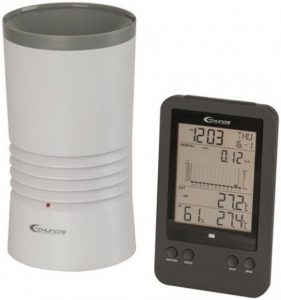If you’re not familiar with an Instrument Choice rain gauge, they generally consist of a clear acrylic or glass cylinder with graduations in inches, centimetres, and millimetres. You can mount these gauges on deck rails, fences, and even the ground. Before you install one, be sure to choose a location that is easy to empty and free from obstructions. Below are some common types of rain gauges.
Standard Rain gauge
 There are many different types of rain gauges on the market. The standard non-recording rain gauge has four main components. First, a 24″ measuring stick is placed through the orifice in the collector funnel. It should extend to the bottom of the measuring tube and then be removed. The liquid collected in the measuring tube will wet the measuring stick. It then is used to calculate the amount of rain or snowfall. A rain gauge should be level to ensure that it is accurate.
There are many different types of rain gauges on the market. The standard non-recording rain gauge has four main components. First, a 24″ measuring stick is placed through the orifice in the collector funnel. It should extend to the bottom of the measuring tube and then be removed. The liquid collected in the measuring tube will wet the measuring stick. It then is used to calculate the amount of rain or snowfall. A rain gauge should be level to ensure that it is accurate.
In addition to determining the total amount of rainfall, the measurement of snowfall should also be taken. The number of snowfalls is calculated based on the water equivalent. Therefore, snow depth is not considered in recording the amount of precipitation. If the snow has been shovelled in the winter months, the snow depth does not count. If you’re concerned about a possible leak in your rain gauge, you can replace the snow-bearing port with a standard rain gauge.
A standard rain gauge will measure the amount of rainfall that falls on the ground. The amount of water that falls on the ground is recorded in m3 or mm. The accuracy of a rain gauge is usually defined as one per cent of the actual amount of precipitation. To calculate this, divide the total amount of rainfall by the amount of resolution of the rain gauge. Then divide the difference between the measured and real amount. If the difference is smaller, the rain gauge is likely to be less accurate.
Tipping bucket rain gauge
The Casella Tipping bucket rain gauge is a durable, dependable, and robust rain gauge for any location. It is designed to be a standalone sensor or integrate with an existing logging system. It has an aluminium alloy funnel with a 400cm2 aperture and a built-in spirit level to accurately measure rainfall amounts. The Casella Tipping bucket rain gauge is easy to deploy, and its minimal maintenance ensures reliable operation and long-term durability.
The Tipping bucket rain gauge’s mechanism automatically tipping action is triggered when a single mm of rain has been collected. A magnet then passes over a sealed reed switch, which counts as a contact closure. As a result, the Tipping bucket rain gauge is highly accurate – typically, its measurement error is less than 1% at 0 to 3.6 inches per hour and +3% above that level. The Instrument Choice rain gauge also comes with a 10-meter cable and a bounce-free reed contact.
A stainless steel rain gauge is a standard for measuring precipitation, and it meets environmental and hydrological testing standards. Its internal tipping bucket structure provides high accuracy across a wide range of rainfall intensities. There are two types of stainless steel tipping bucket rain gauge: an all-stainless steel model and a semi-stainless steel one. The latter is also made of ABS plastic. While all three types of tipping bucket rain gauges are accurate, they are not as reliable as stainless steel ones.
Acoustic rain gauge
An acoustic rain gauge is an instrument that uses sound to measure rainfall intensity. Raindrops make different sounds depending on their size, speed, and frequency. The instrument measures these differences and calculates how much rain has fallen in an area. Meteorologists and hydrologists use the rain gauge to predict the rainy season, large construction projects, and cropping patterns. The device also has a variety of applications, including weather forecasting and flood monitoring.
The current database was developed after recording rain on five days in different locations. The database contains seven rainfall levels and considers the effects of external variable noise. The sound detector was checked continuously to ensure that dirt did not accumulate in the pan, and audio-video recording was used to verify the database. This data was analyzed over multiple days to ensure the accuracy and consistency of the device. Acoustic rain gauges are also ideal for precision agriculture because they reduce the risk of aquaplaning and other road accidents.
The Mark project uses a network of 20 rain gauges located throughout Nebraska, including the Western Nebraska Irrigation Project and the Testing Ag Performance Solutions field in North Platte. Its goal is to validate the technology and demonstrate its value for the agricultural community in local rainfall data. The Instrument Choice rain gauge is also sensitive enough to distinguish between rain and hail without using a manual rain gauge. Instead, you can install the gauge on a post or wall. The cylinder is fastened to the post by an exclusive bracket.
